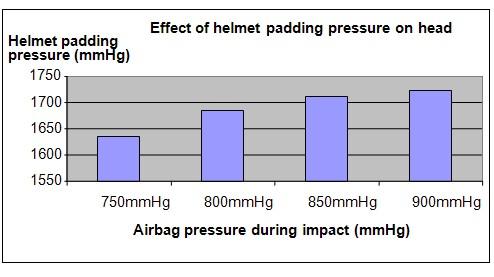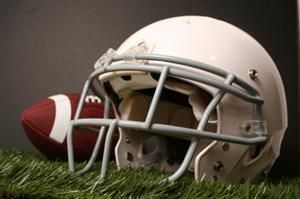| Complexity level: | 7 |
| Project cost ($): | 70 |
| Time required: | Preparation will take approximately two hours, and observation and recording of data will require another two hours |
| Material availability: | Easily found |
| Safety concerns: | Caution should be taken to prevent the falling weight from hitting anyone |
Hypothesis
A higher padding pressure in football helmets will lower the force of impact experienced by players during head-on collisions.
Overview
Football helmet
American football is a popular team sport in the United States. It is also known as Gridiron which is an umbrella term used to refer to similar codes of football in some countries outside North America. This sport is very competitive as it involves both physical play and team strategy. A game will require two teams, a football field, a ball and necessary protective gears for the players.
The football helmet is the most important protective gear and is required for all levels of the game. It is molded using a very hard plastic, and contains a thick padding in its inner walls, a chin strap, a face guard that is made using either metal or plastic bars, and sometimes, a visor to protect the player’s eyes. Inspite of the protection offered by football helmets, players still suffer from head injuries and concussions.
When a head-on collision occurs between two players, the force of the impact is applied directly to the point or area of contact. Such collisions can cause serious injuries if head helmets are not worn. By wearing football helmets, the force of the collision will be transferred to the outer surface of the helmet, after which it will be spread along the inner surface of the helmet. This distribution of force reduces the impact to the player’s head and will therefore reduce the seriousness of any injuries.
Scientific Terms
Materials
Materials required for this science fair project:
- A 2 meter long string
- 1 football helmet
- A 5kg circular weight (~100mm diameter) with a hole in the middle
- 1 bowling ball small enough to fit inside the helmet
- 1 air pump
- 2 pressure gauges1 air bag
- 4 bricks
- 1 chair
- An assistant
Procedure
1. The independent variable in this experiment is the air pressure applied to the padding in the helmet. The dependent variable is the increase in the pressure inside the air bag on collision with the 5 kg weight, which is determined by measuring the maximum deflection in the air pressure gauge. The constants (control variables) are the height at which the weight is dropped , the mass and size of the weight, the size and brand of the helmet, the size of the air bag, and the initial pressure in the air bag.
2. Arrange the four bricks in a square and leave a small hole in the middle as shown in Figure 1. Place the bowling ball in this gap to prevent it from rolling.
3. Increase the pressure of the padding in the helmet to 750 mmHg using the air pump and pressure gauge. Do the same for the pressure in the airbag.

4. Place the airbag on top of the bowling ball with the pressure gauge still connected as shown in Figure 1. Place the football helmet over the airbag.
5. Instruct the assistant to stand on a chair and hold the 2 meter long string vertically with the bottom end touching the center of the helmet (point of impact). Insert the tip of the string through the hole in the 5 kg weight, and release the weight by letting it travel down the length of the string When the 5 kg weight has landed on top of the helmet, note the maximum pressure gauge reading and record it. Repeat the test for five times. Calculate the average pressure readings and record it in the table below.
6. Repeat step 5 after increasing the padding pressure in the helmet to 800 mmHg, 850 mmHg and 900 mmHg. Record the average readings in the table given below.


Results
Increasing the pressure of the padding in the football helmet led to an increase in pressure inside the airbag during collision with the weight.
| Measurement | Effect of different helmet padding pressure on the pressure inside the airbag during collision (mmHg) | |||
| 750 mmHg | 800 mmHg | 850 mmHg | 900 mmHg | |
| Airbag pressure (mmHg) | 1635 | 1685 | 1710 | 1725 |
Use the graph below to plot the experimental data recorded in the table above.

Conclusion
The experimental data and analyzed results do not support the hypothesis that a higher padding pressure in football helmets lowers the force of impact experienced by players during head-on collisions. Instead, the experimental results showed a positive relationship between the pressure in the padding and the pressure in the air bag. This means that a helmet with more pressure in the padding will lead to players suffering a more severe head injury in a collision.
The helmet is the most important protective gear in American football. In the past, players used skull caps made from leather to protect their heads, whereas players nowadays use plastic helmets that are molded using very hard plastic material. Helmets are important as they protect the players from serious head injuries.
Also consider
Try to repeat the science fair project using a wider range of air pressures for the helmet padding.
The science fair project can also be repeated using heavier weights to simulate different collisions.
References
Football helmet - http://en.wikipedia.org/wiki/Football_helmet
How helmets work? - http://januarymagazine.com/features/footballexc.html

